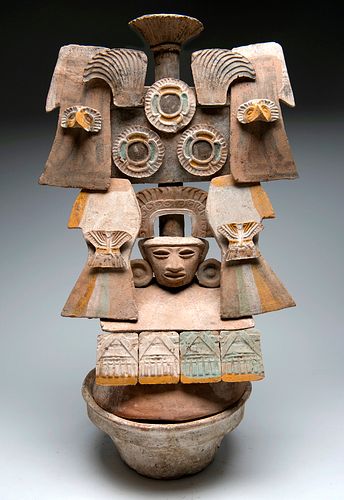Maya Polychrome Incensario w/ Teotihuacan Influence
Lot 103b
About Seller
Artemis Fine Arts
686 S Taylor Ave, Ste 106
Louisville, CO 80027
United States
Selling antiquities, ancient and ethnographic art online since 1993, Artemis Gallery specializes in Classical Antiquities (Egyptian, Greek, Roman, Near Eastern), Asian, Pre-Columbian, African / Tribal / Oceanographic art. Our extensive inventory includes pottery, stone, metal, wood, glass and textil...Read more
Categories
Estimate:
$25,000 - $35,000
Absentee vs Live bid
Two ways to bid:
- Leave a max absentee bid and the platform will bid on your behalf up to your maximum bid during the live auction.
- Bid live during the auction and your bids will be submitted real-time to the auctioneer.
Bid Increments
| Price | Bid Increment |
|---|---|
| $0 | $25 |
| $300 | $50 |
| $1,000 | $100 |
| $2,000 | $250 |
| $5,000 | $500 |
| $10,000 | $1,000 |
| $20,000 | $2,500 |
| $50,000 | $5,000 |
| $100,000 | $10,000 |
| $200,000 | $20,000 |
About Auction
By Artemis Fine Arts
Feb 13, 2020
Set Reminder
2020-02-13 10:00:00
2020-02-13 10:00:00
America/New_York
Bidsquare
Bidsquare : Exceptional Antiquities, Asian, Ethnographic
https://www.bidsquare.com/auctions/artemis-gallery/exceptional-antiquities-asian-ethnographic-4848
An important one-day auction featuring museum-worthy examples of Egyptian, Greek, Roman, Etruscan, Near Eastern, Far East / Asian, Pre-Columbian, African / Tribal, Oceanic, Native American, Spanish Colonial, Russian, Fossils, Ancient Jewelry, Fine Art, so much more! Artemis Fine Arts info@artemisfinearts.com
An important one-day auction featuring museum-worthy examples of Egyptian, Greek, Roman, Etruscan, Near Eastern, Far East / Asian, Pre-Columbian, African / Tribal, Oceanic, Native American, Spanish Colonial, Russian, Fossils, Ancient Jewelry, Fine Art, so much more! Artemis Fine Arts info@artemisfinearts.com
- Lot Description
Pre-Columbian, Guatemala, Maya, inspired by Teotihuacan, ca. 4th century CE. A massive incensario (censer), made from molded and applied ceramic, with ornate symbolic artwork on its two separate components, a lidded round base for holding whatever was burned to create the incense, and an upper section with a long spout for releasing the scent into the room. The spout and upper body are elaborately decorated with a dramatic face of Chaac/Tlaloc, the rain deity who had power over fertility and agriculture, and who, as we see here, is traditionally portrayed with large eyes and an expressionless face. Applied ornaments - decorated with applied flowers, panels featuring mountain-like motifs, bird heads, feathers, and what appear to be butterflies - create a frame around his face, and huge earspools also adorn the visage. White, yellow, and pale blue pigment further embellish this fantastical creation. Size: 17" W x 20" H (43.2 cm x 50.8 cm)
This censer is known as a "theater type" and is among the most emblematic articles of visual culture of Teotihuacan, which then inspired contemporaries and the civilizations that came after them. These were first created in the Tzacualli period (1 to 100 CE), and during the following years, artisans created more and more intricate compositions. Molds were used to make various ornaments that were glued to the primary body and the plates were arranged in superimposed planes as we see in this example. They are known as "theater" because they seem to represent the architecture of a temple, with the mask at the top representing the deity within the temple.
Numerous scholars have suggested that censers like this example were instrumental to a cult dedicated to warriors killed in combat. Incense played a major role in religious practice in Mesoamerica, from the Olmec onward. Many tombs are outfitted with incensarios and the items also seem to have been used in ceremonies by the living. The incense was made from copal, tree resin from the torchwood tree. By burning copal, Mesoamerican priests made an offering to the gods - for example, during an Aztec ceremony for the god Huitzilopochtli, the hummingbird-formed god of war, priests hoped that their prayers would be carried upward along with the wafting smoke and scent.
See a very similar example on the cover of the exhibition book for "Teotihuacan: City of Water, City of Fire" from the de Young Museum (San Francisco), September 30, 2017-February 11, 2018.
See one of a similar form at the Metropolitan Museum of Art (New York) (1999.484.1a, b).
Provenance: private Hawaii, USA collection, purchased in 1998; ex-Ron Messick Gallery, Santa Fe, New Mexico, USA; ex-Allan Stone collection, New York City, USA, 1960 to 1970
All items legal to buy/sell under U.S. Statute covering cultural patrimony Code 2600, CHAPTER 14, and are guaranteed to be as described or your money back.
A Certificate of Authenticity will accompany all winning bids.
We ship worldwide and handle all shipping in-house for your convenience.
#153294Expertly repaired and restored from multiple pieces. This is well done and unobtrusive. Great deposits and original pigment remaining.Condition
- Shipping Info
-
All shipping is handled in-house for your convenience. Your invoice from Artemis Gallery will include shipping calculation instructions. If in doubt, please inquire BEFORE bidding for estimated shipping costs for individual items.
-
- Buyer's Premium



 EUR
EUR CAD
CAD AUD
AUD GBP
GBP MXN
MXN HKD
HKD CNY
CNY MYR
MYR SEK
SEK SGD
SGD CHF
CHF THB
THB













